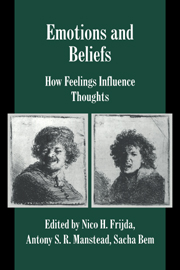Book contents
- Frontmatter
- Contents
- Contributors
- 1 The influence of emotions on beliefs
- 2 Feeling is believing: Some affective influences on belief
- 3 Beliefs through emotions
- 4 The sentiments and beliefs of distributed cognition
- 5 Feeling is believing? The role of processing strategies in mediating affective influences on beliefs
- 6 The formation of beliefs at the interface of affective and cognitive processes
- 7 Anxiety, cognitive biases, and beliefs
- 8 A cognitive dissonance theory perspective on the role of emotion in the maintenance and change of beliefs and attitudes
- 9 Relationship beliefs and emotion: Reciprocal effects
- Index of authors
- Index of subjects
- Studies in Emotion and Social Interaction
1 - The influence of emotions on beliefs
Published online by Cambridge University Press: 10 March 2010
- Frontmatter
- Contents
- Contributors
- 1 The influence of emotions on beliefs
- 2 Feeling is believing: Some affective influences on belief
- 3 Beliefs through emotions
- 4 The sentiments and beliefs of distributed cognition
- 5 Feeling is believing? The role of processing strategies in mediating affective influences on beliefs
- 6 The formation of beliefs at the interface of affective and cognitive processes
- 7 Anxiety, cognitive biases, and beliefs
- 8 A cognitive dissonance theory perspective on the role of emotion in the maintenance and change of beliefs and attitudes
- 9 Relationship beliefs and emotion: Reciprocal effects
- Index of authors
- Index of subjects
- Studies in Emotion and Social Interaction
Summary
Emotion theory has changed quite dramatically during the last three decades. To a large extent this change has been due to a keen interest in the role of cognition in emotion. We have seen the emergence of “cognitive emotion theory” (e.g., Lazarus, 1991), which has in turn stimulated a considerable body of research. Within this theory, beliefs are viewed as major antecedents of emotions, a point that is particularly emphasized by what is known as “appraisal theory” (e.g., Scherer, 1999). According to appraisal theory, emotions result from how the individual believes the world to be, how events are believed to have come about, and what implications events are believed to have.
Beliefs thus are regarded as one of the major determinants of emotion, and therefore an important part of the study of emotion can properly be seen as falling under the umbrella of cognitive psychology. Oddly enough, however, the reverse direction of influence in the relation between emotion and cognition has received scant attention. This is in itself rather odd, because one might easily regard emotions as being among the determinants of an individual's beliefs. They can be seen as influencing the content and the strength of an individual's beliefs, and their resistance to modification. Indeed, such an influence has traditionally been considered to be one of the most important things to be said about emotions. Spinoza (1677/1989) defined emotions as “states that make the mind inclined to think one thing rather than another.”
- Type
- Chapter
- Information
- Emotions and BeliefsHow Feelings Influence Thoughts, pp. 1 - 9Publisher: Cambridge University PressPrint publication year: 2000
- 36
- Cited by



